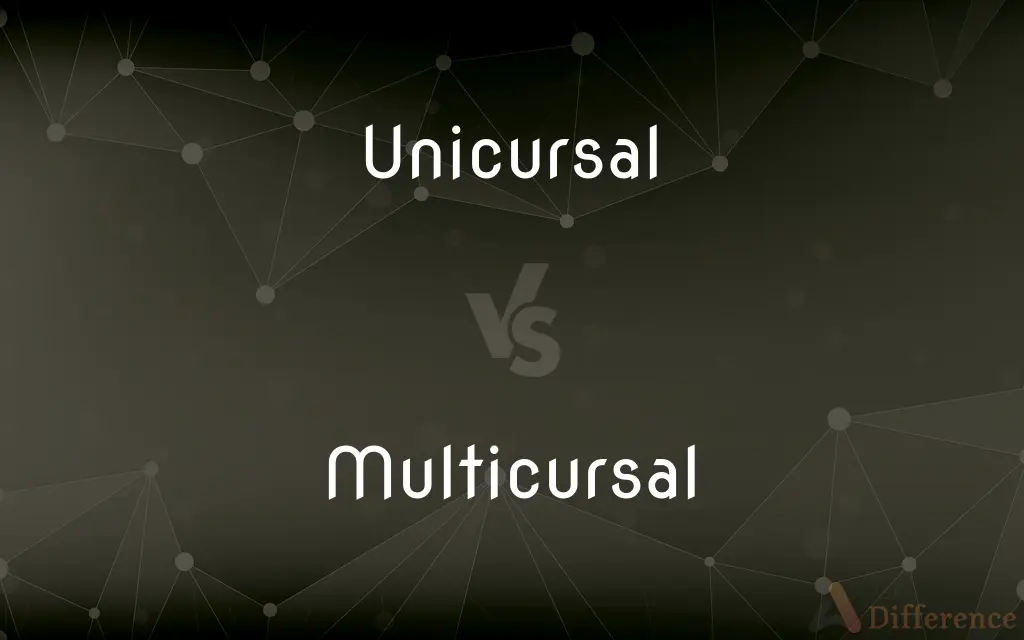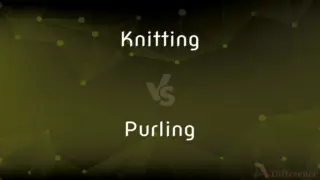Unicursal vs. Multicursal — What's the Difference?
By Urooj Arif & Fiza Rafique — Updated on March 20, 2024
Unicursal mazes have a single path leading from entrance to goal, while multicursal mazes offer multiple paths, often with dead ends.

Difference Between Unicursal and Multicursal
Table of Contents
ADVERTISEMENT
Key Differences
Unicursal mazes, or labyrinths, feature a single, non-branching path that leads directly to the center or goal, ensuring that every turn and twist inevitably brings one closer to the end. In contrast, multicursal mazes present a complex network of choices, with paths that may branch, intersect, and dead-end, challenging the navigator to find the correct route among many possible ones.
The experience of navigating a unicursal maze is meditative and predictable, as there is no possibility of getting lost, only a single journey from start to finish. Whereas navigating a multicursal maze is a puzzle-solving process that requires decision-making and may involve backtracking and remembering previous choices.
Unicursal mazes are often used in spiritual or ritual contexts, symbolizing a journey of self-discovery or a spiritual quest with a clear path to enlightenment or understanding. Multicursal mazes, on the other hand, are commonly used for entertainment, education, and as a metaphor for life's challenges, representing the many choices and obstacles one might face.
The design of a unicursal maze is generally simpler, focusing on the aesthetic and experiential journey along the single path. Multicursal mazes are designed to be complex and challenging, with the intention of confounding and delighting the solver with twists, turns, and dead ends.
Historically, unicursal designs can be found in ancient cultures and religious contexts, symbolizing unity and wholeness. Multicursal mazes became popular in gardens and entertainment venues, especially from the Renaissance onwards, embodying the human love for puzzles and exploration.
ADVERTISEMENT
Comparison Chart
Paths
Single, non-branching path
Multiple paths with choices and dead ends
Navigation
Straightforward, no possibility of getting lost
Requires decision-making and problem-solving
Purpose
Often spiritual or meditative
Entertainment, education, metaphor for life's challenges
Design Complexity
Simpler, focusing on the journey
Complex, intended to challenge and confound
Historical Use
Ancient and religious contexts
Renaissance gardens, entertainment venues
Compare with Definitions
Unicursal
Features only one path from entrance to goal.
The labyrinth at Chartres Cathedral is a famous unicursal design.
Multicursal
Used for fun and to develop problem-solving skills.
Garden mazes serve as entertainment and learning experiences for visitors.
Unicursal
Often used for contemplation and meditation.
Walking a unicursal labyrinth can be a calming, reflective experience.
Multicursal
Challenges navigators to find the correct path.
Multicursal mazes are often featured in puzzle books and games.
Unicursal
Represents a spiritual or personal journey.
Unicursal labyrinths are often used in spiritual practices as a symbol of life's path.
Multicursal
Contains branching paths with options and dead ends.
The hedge mazes in European gardens are classic multicursal designs.
Unicursal
Lacks branches or choices, ensuring a smooth journey.
Unicursal mazes provide a predictable path without obstacles.
Multicursal
Designed to confuse and challenge.
Multicursal mazes may use visual tricks and dead ends to add difficulty.
Unicursal
Found in ancient and religious contexts.
Ancient unicursal designs can be seen in rock carvings and religious buildings.
Multicursal
Intentionally intricate to provide a challenge.
The design of multicursal mazes often involves complex algorithms or artistic creativity.
Unicursal
Being composed entirely of a single continuous path or line.
Multicursal
Of a maze or labyrinth: having more than one possible route between the centre and the outside.
Unicursal
On one path of a moving element.
Unicursal
An object or figure composed entirely of a single continuous path or line (e.g. a turf maze)
Unicursal
That can be passed over in a single course; - said of a curve when the coördinates of the point on the curve can be expressed as rational algebraic functions of a single parameter
Common Curiosities
What is the main difference between unicursal and multicursal mazes?
Unicursal mazes have a single path without branches, leading directly to the goal, while multicursal mazes feature multiple paths, including choices and dead ends.
How are multicursal mazes designed?
They are intricately planned with branching paths, dead ends, and sometimes puzzles, to challenge and confound the navigator.
Can you get lost in a unicursal maze?
No, the single, non-branching path of a unicursal maze means you cannot get lost; there's only one way to go.
What is the purpose of a multicursal maze?
Multicursal mazes are designed for entertainment, education, and as metaphors for life's challenges, requiring problem-solving to navigate.
Why are unicursal mazes considered meditative?
The predictable, non-branching path allows for a reflective, uninterrupted journey, often used in spiritual and meditative practices.
Are multicursal mazes used only for entertainment?
While often used for entertainment, they also serve educational purposes and as tools for cognitive development and problem-solving skills.
Can a multicursal maze have more than one solution?
Yes, some multicursal mazes are designed with multiple valid paths to the end, adding to their complexity.
Do all cultures have a tradition of maze designs?
Many cultures around the world have maze designs, though their meanings and uses can vary widely.
What is an example of a famous unicursal maze?
The labyrinth in Chartres Cathedral in France is a well-known example.
Are there digital versions of unicursal and multicursal mazes?
Yes, both types of mazes are popular in digital form, ranging from simple apps to complex video game puzzles.
How old are unicursal designs?
Unicursal designs can be traced back to ancient civilizations, making them thousands of years old.
How are unicursal mazes used in modern times?
They are used in spiritual and therapeutic settings, for meditation, and as decorative elements in gardens and architecture.
Can multicursal mazes be found in nature?
Natural multicursal patterns can occur, but most intricate multicursal mazes are human-made.
What is the symbolism behind a unicursal maze?
They often symbolize a journey of self-discovery, spiritual path, or the journey of life with a clear direction.
What makes a multicursal maze difficult?
The complexity comes from its branching paths, dead ends, and the need to choose the correct path among many options.
Share Your Discovery

Previous Comparison
Knitting vs. Purling
Next Comparison
Community vs. LocalityAuthor Spotlight
Written by
Urooj ArifUrooj is a skilled content writer at Ask Difference, known for her exceptional ability to simplify complex topics into engaging and informative content. With a passion for research and a flair for clear, concise writing, she consistently delivers articles that resonate with our diverse audience.
Co-written by
Fiza RafiqueFiza Rafique is a skilled content writer at AskDifference.com, where she meticulously refines and enhances written pieces. Drawing from her vast editorial expertise, Fiza ensures clarity, accuracy, and precision in every article. Passionate about language, she continually seeks to elevate the quality of content for readers worldwide.
















































